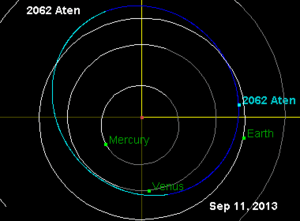2062 Aten
|
Orbital diagram of the Aten asteroid, with location as of September 11, 2013 | |
| Discovery | |
|---|---|
| Discovered by | Eleanor F. Helin |
| Discovery site | Palomar |
| Discovery date | January 7, 1976 |
| Designations | |
Named after | Aten |
| 1976 AA | |
| Aten asteroid[1] | |
| Orbital characteristics | |
| Epoch July 14, 2004 (JD 2453200.5) | |
| Aphelion | 171.038 Gm (1.143 AU) |
| Perihelion | 118.197 Gm (0.790 AU) |
| 144.617 Gm (0.967 AU) | |
| Eccentricity | 0.183 |
| 347.168 d (0.95 a) | |
Average orbital speed | 30.04 km/s |
| 225.354° | |
| Inclination | 18.932° |
| 108.635° | |
| 147.946° | |
| Physical characteristics | |
| Dimensions | 1.1 km[1] |
| Mass | 7.6×1011 kg |
Mean density | 2 ? g/cm³ |
| 0.000 25 m/s² | |
| 0.000 48 km/s | |
| 40.77 hr[1] | |
| Albedo | 0.26[1] |
| Temperature | ~275 K |
Spectral type | S[1] |
| 16.80[1] | |
|
| |
2062 Aten (/ˈɑːtən/)[2] is an asteroid that was discovered at the Palomar Mountain Observatory by Eleanor F. Helin, who is now the principal scientist for the NEAT (Near-Earth Asteroid Tracking) project. It is named after Aten, the Egyptian god of the solar disk.
Aten was the first asteroid found to have a semi-major orbital axis of less than one astronomical unit. A new category of asteroids was thus created, the Atens. As of July 2004 about 16 Atens were numbered and some 212 were provisional,[3] the unnumbered Atens ranged from what was then 1989 VA to 2004 MD6.
References
- ↑ 1.0 1.1 1.2 1.3 1.4 1.5 "JPL Small-Body Database Browser: 2062 Aten (1976 AA)" (2014-02-14 last obs (arc=58 yr)). Jet Propulsion Laboratory. Retrieved 2014-02-23.
- ↑ Oxford English Dictionary
- ↑ "NEO Discovery Statistics". Retrieved 2014-02-26.
External links
| ||||||
| ||||||||||||||||||||||||||||
